We’d like to check in单元教案
人教版八年级英语下册第二单元教案
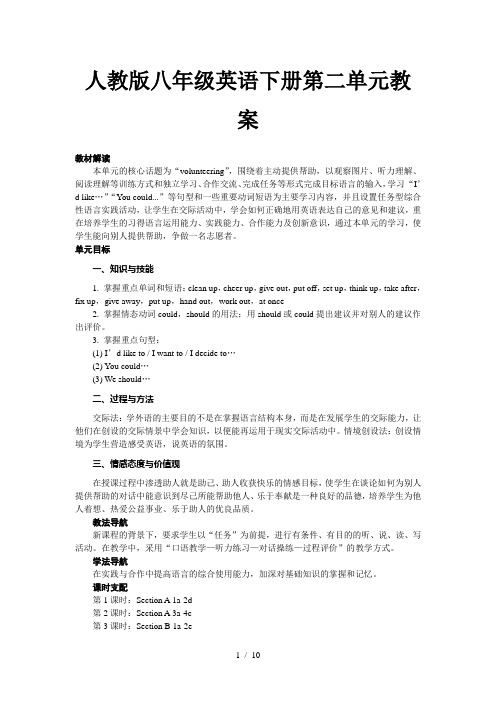
人教版八年级英语下册第二单元教案教材解读本单元的核心话题为“volunteering”,围绕着主动提供帮助,以观察图片、听力理解、阅读理解等训练方式和独立学习、合作交流、完成任务等形式完成目标语言的输入,学习“I’d like…”“You could...”等句型和一些重要动词短语为主要学习内容,并且设置任务型综合性语言实践活动,让学生在交际活动中,学会如何正确地用英语表达自己的意见和建议,重在培养学生的习得语言运用能力、实践能力、合作能力及创新意识,通过本单元的学习,使学生能向别人提供帮助,争做一名志愿者。
单元目标一、知识与技能1. 掌握重点单词和短语:clean up,cheer up,give out,put off,set up,think up,take after,fix up,give away,put up,hand out,work out,at once2. 掌握情态动词could,should的用法;用should或could提出建议并对别人的建议作出评价。
3. 掌握重点句型:(1) I’d like to / I want to / I decide to…(2) You could…(3) We should…二、过程与方法交际法:学外语的主要目的不是在掌握语言结构本身,而是在发展学生的交际能力,让他们在创设的交际情景中学会知识,以便能再运用于现实交际活动中。
情境创设法:创设情境为学生营造感受英语,说英语的氛围。
三、情感态度与价值观在授课过程中渗透助人就是助己、助人收获快乐的情感目标,使学生在谈论如何为别人提供帮助的对话中能意识到尽己所能帮助他人、乐于奉献是一种良好的品德,培养学生为他人着想、热爱公益事业、乐于助人的优良品质。
教法导航新课程的背景下,要求学生以“任务”为前提,进行有条件、有目的的听、说、读、写活动。
在教学中,采用“口语教学—听力练习—对话操练—过程评价”的教学方式。
We’d like to check in教学设计说课.pptx [恢复]
![We’d like to check in教学设计说课.pptx [恢复]](https://img.taocdn.com/s3/m/5383126e0b1c59eef8c7b4b9.png)
课前准备
自主学习 15’
三步学习 层层深入
展示评价 10’
学习反馈
自行预习
教学过程设计
课前准备
自行预习
教学过程设计
视频呈现
复习导入 5 ’
教学过程设计
1.复习:单词练习:连线关于酒店设备设施的单词和 图片,系统将自动评分计入个人成绩(3’)
1.
restaurant
2.
garden
3.
swimming pool
We’d like to check in
航空系 xx
We’d like to check in
TM
教学设计
INSTRUCTIONAL DESIGN
2014 Apr. 21th
目录 目录
教学任务分析 教学方法选择 教学过程设计 教学特点总结
教学难点 教学重点
教学目标
学情分析
教学 任务 分析 教材分析
能力目标 学情分析
教学目标 1.能够询问并给予乘客酒店信息 2.能够根据乘客自身情况,帮助其申请入住相关酒店
情感目标
通过为乘客介绍酒店的相关表达,来增强说英语 的自信心
教材分析
教学 任务 分 析
教学重点 掌握宾馆房间设施的单词如air conditioning, internet access等和重点 句型the position of the hotel is……, the facilities of the hotel are……, the 学情分析 price of the room is……
小组探究 15’
教学过程设计
展示及评价:每组选取一 名同学代表向全体展示小 组的酒店介绍,包括图片 及视频等辅助材料的上传, 之后其他小组根据评价标 准给予评分,最后教师给 予小组评分并总结。
探究式教学【教学设计新部编版】Module 9 Unit 2(英语外研三上)
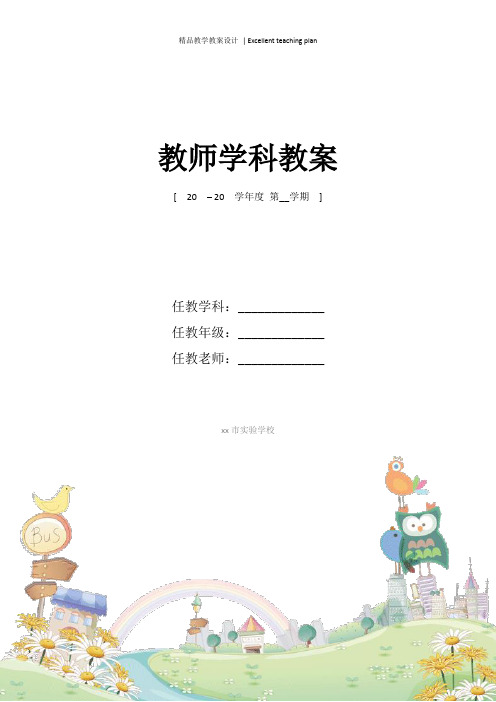
教师学科教案[ 20 – 20 学年度第__学期]任教学科:_____________任教年级:_____________任教老师:_____________xx市实验学校Module 9 Unit 2I’m going to be a driver?本课时编写:上海市上外苏河湾中学张海舟教学模式介绍探究式教学模式是指在教学过程中,要求学生在教师指导下,通过以“自主、探究、合作”为特征的学习方式对当前教学内容中的主要知识点进行自主学习、深入探究并进行小组合作交流,从而较好地达到课程标准中关于认知目标与情感目标要求的一种教学模式。
其中认知目标涉及与学科相关知识、概念、原理与能力的掌握;情感目标则涉及思想感情与道德品质的培养。
探究式课堂教学模式的教学环节:创设情境——启发思考——自主(或小组)探究——协作交流——总结提高教材分析本节课教学内容是外研社一年级起点新标准英语第五册Module 9 Unit 2 I'm going to be a driver.单元重点学习谈论自己的理想。
在本课中,学生将开始使用be going to 来表达自己的理想职业,同时学生将会接触一些职业的说法。
【知识与能力目标】1. 能够复习、结合句子综合练说nurse, teacher, train driver, taxi driver, bus driver, doctor, policeman;2. 熟练运用be going to do sth.,能够用这种句型来表达自己的打算。
【过程与方法目标】1. 听懂故事,能跟磁带朗读故事;能在图片的帮助下简单复述故事。
2. 学生能够运用本课的语句和词汇讨论将来的职业。
【情感态度价值观目标】1. 通过小组合作完成学习任务,培养学生的集体观念。
2. 使他们更加有理想,并为实现自己的理想而不断努力。
教学重难点【教学重点】1. 能够理解运用What are you going to be?提问并且用I’m going to be…句型回答描述将来自己的理想职业。
2024-2025学年外研版初中英语八年级(上)教案Module5Unit1
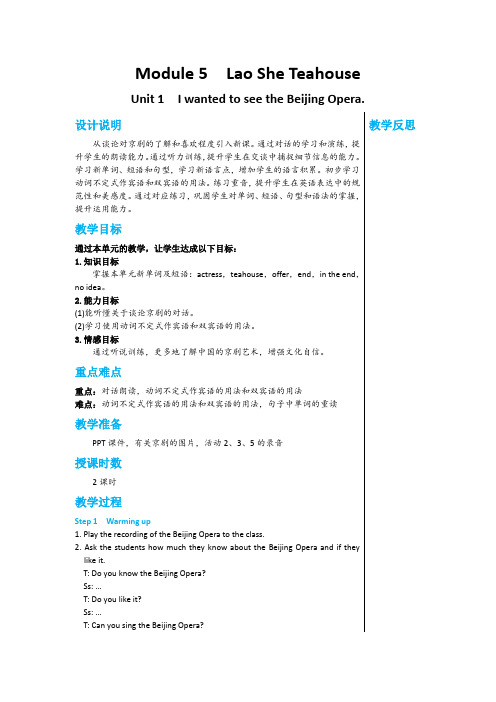
Module 5Lao She TeahouseUnit 1I wanted to see the Beijing Opera.设计说明教学反思从谈论对京剧的了解和喜欢程度引入新课。
通过对话的学习和演练,提升学生的朗读能力。
通过听力训练,提升学生在交谈中捕捉细节信息的能力。
学习新单词、短语和句型,学习新语言点,增加学生的语言积累。
初步学习动词不定式作宾语和双宾语的用法。
练习重音,提升学生在英语表达中的规范性和美感度。
通过对应练习,巩固学生对单词、短语、句型和语法的掌握,提升运用能力。
教学目标通过本单元的教学,让学生达成以下目标:1.知识目标掌握本单元新单词及短语:actress,teahouse,offer,end,in the end,no idea。
2.能力目标(1)能听懂关于谈论京剧的对话。
(2)学习使用动词不定式作宾语和双宾语的用法。
3.情感目标通过听说训练,更多地了解中国的京剧艺术,增强文化自信。
重点难点重点:对话朗读,动词不定式作宾语的用法和双宾语的用法难点:动词不定式作宾语的用法和双宾语的用法,句子中单词的重读教学准备PPT课件,有关京剧的图片,活动2、3、5的录音授课时数2课时教学过程Step 1Warming up1. Play the recording of the Beijing Opera to the class.2. Ask the students how much they know about the Beijing Opera and if theylike it.T: Do you know the Beijing Opera?Ss: …T: Do you like it?Ss: …T: Can you sing the Beijing Opera?Ss: …Step 2PresentationWork in pairs. Look at the pictures and talk about them. Use the words in the box to help you. (Activity 1 on Page 34)1. Ask the students to look at the pictures.2. Tell them to read through the words and make sure they know the meaningactress dance music play sing teahouse theatre traditional3. Ask them to describe the pictures in pairs.4. Encourage some pairs to present their conversations.Step 3Listening1. Let the students listen and underline the correct words or expressions. (Activity 2 on Page 34)(1) Ask the students to read the three sentences.(2) Play the recording and ask the students to choose the correct answers.(3) Have the students check answers with their partners.(4) Check answers and read full sentences with the students.Answers: 1 wants to see 2 doesn’t know 3 difficult(5) Play the recording again. Show the tapescript if necessary.Step 4Listening and reading1. Introduce the playwright Lao She and his play Teahouse to the class.2. Play the recording and ask the students to check the true sentences. (Activity3 on P35)(1) Read through the sentences and try to understand them.(2) Listen to the recording. Then check the true sentences.(3) Elicit the answers from the class.Answers: 3√4√5√3. Listen again and try to get answers to the question.1. Who went to Lao She Teahouse last night?2. Did Betty like the Beijing Opera?3. How long did they stay there in the end?4. Does Lingling often go to see the Beijing Opera?5. What is Lao She famous for?(1) Ask the students to read through the sentences and try to understand them.(2) Listen to the recording and try to get the answers. Allow some students toread the conversation if they still can’t get the answers after listening.(3) Elicit answers in full sentences for the class.Answers:1 Lingling and Betty.2 Yes, she did.3 They stayed there for three hours.4 No, she doesn’t.5 He is famous for his play Teahouse.4. Read the conversation again and find out the following phrases. Try to5. Listen to the conversation and read it.(1) Ask the students to listen to the recording and then try to read the conversation on their own.(2) Ask or encourage some students to read the conversation. Correct their mistakes.(3) Ask some students to practice the conversation in different roles.Step 5PracticeComplete the passage with the correct form of the words in the box. (Activity 4 on Page 35)(1) Read through the words in the box.complete it with the correct form of the words in the box on their own.(3) Check answers in groups.(4) Elicit answers from the class.Answers:(1) offered (2) difficult(3) actresses (4) end (5) mainStep 6Language points1. You know,I wanted to see the Beijing Opera,so Lingling offered to take me there. 你知道,我想看京剧,因此玲玲主动提出带我去那儿。
2022年外研版八年级上册Module 3 Unit 3教案
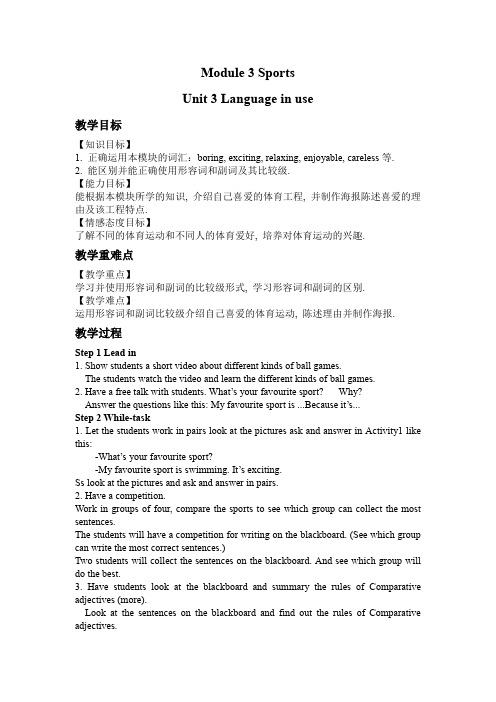
Module 3 SportsUnit 3 Language in use教学目标【知识目标】1. 正确运用本模块的词汇:boring, exciting, relaxing, enjoyable, careless等.2. 能区别并能正确使用形容词和副词及其比较级.【能力目标】能根据本模块所学的知识, 介绍自己喜爱的体育工程, 并制作海报陈述喜爱的理由及该工程特点.【情感态度目标】了解不同的体育运动和不同人的体育爱好, 培养对体育运动的兴趣.教学重难点【教学重点】学习并使用形容词和副词的比较级形式, 学习形容词和副词的区别.【教学难点】运用形容词和副词比较级介绍自己喜爱的体育运动, 陈述理由并制作海报.教学过程Step 1 Lead in1. Show students a short video about different kinds of ball games.The students watch the video and learn the different kinds of ball games.2. Have a free talk with students. What’s your favourite sport? Why?Answer the questions like this: My favourite sport is ...Because it’s...Step 2 While-task1. Let the students work in pairs look at the pictures ask and answer in Activity1 like this:-What’s your favourite sport?-My favourite sport is swimming. It’s exciting.Ss look at the pictures and ask and answer in pairs.2. Have a competition.Work in groups of four, compare the sports to see which group can collect the most sentences.The students will have a competition for writing on the blackboard. (See which group can write the most correct sentences.)Two students will collect the sentences on the blackboard. And see which group will do the best.3. Have students look at the blackboard and summary the rules of Comparative adjectives (more).Look at the sentences on the blackboard and find out the rules of Comparative adjectives.4. Show students two sentences and ask them to find out the usage between adjectivesand adverbs.5. Have students make sentences with adjectives and adverbs.Step 3 Post-task1. Have students work in groups and complete the sentences and passage with thewords in the brackets of Activity 2-4.2. Call back the answers.3. Ask the students to work in groups talk about their favourite Olympic sports andmake a sports poster.Work in groups talk about their favourite Olympic sports and make a sports poster.A: What’s your favourite Olympic sport?B: My favourite Olympic sport is...A: Why do you like it?B: I like it because...Step 4 SummaryAsk the students to conclude the usage of adjectives and adverbs and their comparative.课堂作业Write an email to your best friend about your favourite sport.教学反思Module 5 Lao She Teahouse一、教学内容:Unit 3 Language in use二、课型:Revision and application三、教学目标:1. 正确运用本模块的词汇及短语2、掌握动词不定式作宾语的用法. 并能通过小组合作, 把一部戏剧中的一幕改编成短剧并在班上表演.四、教学重难点:掌握动词不定式作宾语的用法. 并能通过小组合作, 把一部戏剧中的一幕改编成短剧并在班上表演.五、教学准备:本节课型为Revision and application, 根据新课标的要求, 结合教材和学生特点, 主要采用任务型互动式进行教学, 结合情景法、交际法、听说法、归纳法等教学方法实施课堂活动, 开启学生思维, 通过一系列有条理的教学活动, 引导学生自主探究学习和与他人互动合作学习, 让学生体验愉快学习. 本节课所需教具及资料:幻灯、图片、调查表等.六、教学过程:达标训练题一、单项选择.〔〕1. Let’s _________ for a walk, shall we?- ____________,A. to goB. goingC. goD. gone( ) 2. The boss made the workers ________ the job on time.A. finish finished C. finishes D. to finish( ) 3. It’s necessary for us __________ Mont Yuntai.A. go climbingB. go to climbC. to go climbingD. goes climbing( ) 4. - Mary, What’s that? - A card. Linda ______ it _______me yesterday.A. sent ; forB. sent ; toC. gives ; forD. gives; to( ) 5. I decide ________ a translator in the future.A. beB. to beC. beingD. am二、阅读理解Most people make their living〔谋生〕with their hands, but Bob makes his living with his feet.Bob’s story began in a small city in England. His parents were poor. Seven people lived in a small house. Bob had no place to play but on the street.Bob’s father often played football. Little Bob wanted to play football, too. So his father made a soft 〔柔软的〕ball for him to kick. It was a sock full of old cloth. He kicked it every day.At last , Bob learned to kick a real football. And after a few years he could play football very well.根据短文内容, 选择最正确答案.( ) 1.People usually make their living ______________.A. by learning by themselvesB. with their feetC. by playing footballD. with their hands( ) 2. Which of the following is TRUE?A. Bob was born in a small village.B. Bob’s house was very big.C. There were eight people in the family.D. The little boy often played on the street.( ) 3. Why did the father make a soft ball for his son ?A. Because the family all liked footballB. Because Bob also liked to play football.C. Because they had a lot of old cloth.D. Because he didn’t want to throw the sock away.( ) 4. The word “ kick〞in the story means ________.A. 踢B. 玩C. 射门D.弹起( ) 5. From the story we can see _________________.A. Bob’s ageB. it’s about an American boyC. Bob’s mother’s nameD. the boy became a good football player at last.。
Unit 8 Do you have a soccer ball 单元整体教案+课时教案(6课时)

Unit 8 Do you have a soccer ball 单元整体教案+课时教案(6课时)Unit8 Do you have a soccer ball【教学目标与要求】●话题::与朋友共度快乐时光(Spending time with friends)●功能:能够询问并描述物品所属关系(Talking about ownership)A; Do you have a ping-pong bat B: Yes, I do. / No, I don’t.A: Does she have a tennis ball B: Yes, she does. / No, she doesn’t.I don’t have a computer game.He has two ping-pong bats.●语法:1. 能够正确使用have 的一般现在时用法(Present tense to have)Do you have a volleyball Does she have a tennis ballWe have a basketball. They don’t have a basketball.He doesn’t have a soccer ball. She has a baseball.2.能够正确使用一般疑问句询问物品所属关系并做简略回答。
(Yes/ No questions and short answers)A: Do you have a tennis ball, JaneB: Yes, I do. / No, I don’t.A: Does he have a soccer ballB: Yes, he does. / No, he doesn’t.3. 能够正确使用形容词对事物发表基本看法,(adjectives of quality) Interesting, difficult, boring, relaxing, fun4. 能正确使用连词but(conjunction but)。
unit8 We'd like to check in

读下文,在文中标出这家
on the second floor, and the bar is there, too.
Outside, we have a tennis court and a garden with lovely flowers and trees.
Please enjoy your stay here!
Clerk: Hello, may I help you? Mr. Smith: Yes. I’d like to check in, please. My name is John Smith. Clerk: Just a moment. Yes, Mr. Smith, you’ve booked a suite. Mr. Smith: That’s right. Clerk: Here’s your key card. Enjoy your stay. Mr. Smith: Thank you.
单人间
Warming up
double room
(有一张双人床的)双人房间
Warmi张单人床的)双人房间
Listening and Speaking
1
Listen and learn.
bellboy desk clerk
听录音,了解酒店的一些工作岗位。
n. 行李员
S2: A single room, please.
S1: May I have your name, sir? S2: Jack Brown.
a salesman/single room
Listening and Speaking
4 Listen and practice. 听录音,练习办理入住手续。
初一英语音标教案

初一英语音标教案初一英语音标教案1一、教材分析本单元是人教版《新目标》的第十二单元。
这本教材的词汇量很大,内容新颖,尤其是生动活泼的卡通化的画面,很符合七年级学生的年龄特点和心理特点,其中还囊括了很丰富多彩的文化知识,以及合作探究的活动,十分贴近学生的实际生活经验。
本单元的话题Talk about rules.与日常生活密切相关。
作为一名中学生,遵守学校班级、家庭和社会公共场所的规章制度是必须的。
在谈论规则时,一般运用祈使句、情态动词can和have to等。
这是英语新课程标准中规定所必须掌握的内容,是交际英语中必不可少的项目。
因此,本单元对于提升学生的学习兴趣而提高学生的听、说、读、写能力有很大的帮助。
并通过self check检测,积极地、及时地寻找各自的不足,以便学生树立良好的内在动机,不断获得成就感。
二、教学目标1、教学目标⑴知识目标这一单元主要话题是“Talk about rules谈论规则”,其中主要涉及内容如下:A、Functions功能:谈论规则,并制定规则。
B、Structures语法结构:祈使句和情态动词Can和have to的用法。
C、Target Language日常交际用语:Don’t eat in class!Can we wear hats?No,we can’t.We don’t have to wear a school uniform等。
D、Vocabulary词汇:rule、classroom、hallway、fight、have to等。
(2)能力目标培养学生运用所学句型谈论规则的能力,并培养学生遵守规则的习惯。
(3)情感目标A、谈论规则有利于学生守秩序,遵纪守法,使学生感受到自觉遵守各项规章制度的好处。
B、有些规则是必要的,但规则太多却使人感厌烦!学生在遵守规则的过程中会体验到不同的情感。
2、教学重点、难点(1)重点:学习并运用谈论规则的日常交际用语及词汇。
教学设计2:Unit 10 第四课时
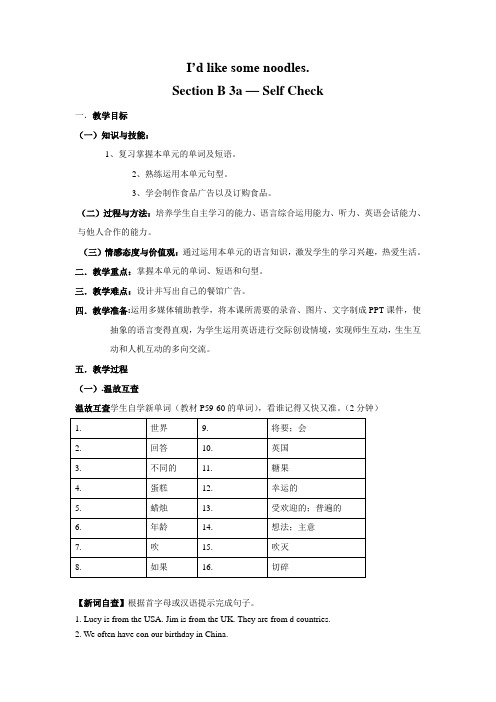
I’d like some noodles.Section B 3a — Self Check一.教学目标(一)知识与技能:1、复习掌握本单元的单词及短语。
2、熟练运用本单元句型。
3、学会制作食品广告以及订购食品。
(二)过程与方法:培养学生自主学习的能力、语言综合运用能力、听力、英语会话能力、与他人合作的能力。
(三)情感态度与价值观:通过运用本单元的语言知识,激发学生的学习兴趣,热爱生活。
二.教学重点:掌握本单元的单词、短语和句型。
三.教学难点:设计并写出自己的餐馆广告。
四.教学准备:运用多媒体辅助教学,将本课所需要的录音、图片、文字制成PPT课件,使抽象的语言变得直观,为学生运用英语进行交际创设情境,实现师生互动,生生互动和人机互动的多向交流。
五.教学过程(一).温故互查温故互查学生自学新单词(教材P59-60的单词),看谁记得又快又准。
(2分钟)【新词自查】根据首字母或汉语提示完成句子。
1. Lucy is from the USA. Jim is from the UK. They are from d countries.2. We often have con our birthday in China.KFCTel: 62550011Address: 28 Bridge Street Open: 9:00 a.m.~11:00 p.m. Food: fried chicken, French fries, hamburgers, porridge Drink : coke, coffee, milk, juice Dessert: ice creamSoup: vegetable soupBig Pizza(比萨饼)Tel: 88819056Address: 102 Ting Street Open: 9:30a.m.~12:00 p.m. Food: beef pizza, mutton pizza fruit pizza, vegetable pizza Drink: coffee, milk, fruit, juice Dessert: ice creamSoup: Italy (意大利) soups3. The number of c is the person’s age.4. Iyou have nothing to do this afternoon, let’s play basketball5. He is very l to have a special birthday party.6. It is very p to wear this kind of skirt this year.7. You should b (吹灭)all the candles in one go.8. Please c (切碎)the apples and put them in the bowl.(二).设问导读:1.新课呈现Step1 Review & Lead-in1.Read 2b on P59 together.2.Put the words you learned in different groups. Finish SelfCheck: Ex.1.3.Finish Self Check: Ex.2: Complete the sentences with the there be structure.4.Write a conversation with the help of the clues.Step2 Presentation 1.Go through the words in the box quickly.2.Fill in the blanks in the ad with the words. Finish 3a. Check the answers.3.Read the adtogether.Step3 WritingGroup work: 1. Imagine you have a restaurant. Write the foods and their prices.2. Write an ad for your restaurant. Finish 3b.3. Show time: show your ad to the class.II、合作交流Group work: 分析总结如何设计并写出自己的餐馆广告。
仁爱版九年级英语上册Unit3Topic1SectionD教案
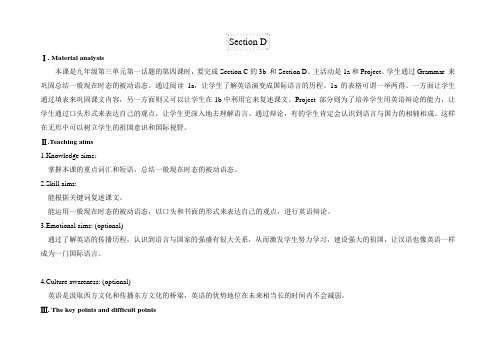
Section DⅠ. Material analysis本课是九年级第三单元第一话题的第四课时,要完成Section C的3b 和Section D。
主活动是1a和Project。
学生通过Grammar 来巩固总结一般现在时态的被动语态。
通过阅读1a,让学生了解英语演变成国际语言的历程。
1a的表格可谓一举两得。
一方面让学生通过填表来巩固课文内容,另一方面则又可以让学生在1b中利用它来复述课文。
Project 部分则为了培养学生用英语辩论的能力,让学生通过口头形式来表达自己的观点,让学生更深入地去理解语言。
通过辩论,有的学生肯定会认识到语言与国力的相辅相成。
这样在无形中可以树立学生的祖国意识和国际视野。
Ⅱ.Teaching aims1.Knowledge aims:掌握本课的重点词汇和短语,总结一般现在时态的被动语态。
2.Skill aims:能根据关键词复述课文。
能运用一般现在时态的被动语态,以口头和书面的形式来表达自己的观点,进行英语辩论。
3.Emotional aims: (optional)通过了解英语的传播历程,认识到语言与国家的强盛有很大关系,从而激发学生努力学习,建设强大的祖国,让汉语也像英语一样成为一门国际语言。
4.Culture awareness: (optional)英语是汲取西方文化和传播东方文化的桥梁,英语的优势地位在未来相当长的时间内不会减弱。
Ⅲ. The key points and difficult points1. Key points:Words and phrases: Britain, powerful, leading, position, take the leading position, as a result, encourage sb.to do sth., be popular with sb., make great progress in doing sth., be required to do sth., be regarded as.Sentences: The American computer and Internet industry have taken the leading position in the world.Many of them have done well in English and have made great progress in speaking it.Grammar: the simple present passive voice.2. Difficult points:理解英国的不同称呼:UK, the United Kingdom, Great Britain。
Module 4 单元(教案)外研版(三起)英语三年级上册

Module 4 单元(教案)外研版(三起)英语三年级上册一、教学目标通过本课教学,学生能够:1.熟练掌握动词组 be good at 和动词短语 like doing sth. 的用法;2.通过本单元学习的词汇及句型,能够描述自己和他人的技能和爱好;3.通过小组合作,能够向他人介绍自己和他人的技能和爱好。
二、教学重点1.动词组 be good at 的用法;2.动词短语 like doing sth. 的用法;3.描述自己和他人的技能和爱好。
三、教学难点小组合作,向他人介绍自己和他人的技能和爱好。
四、教学准备1.教师:黑板、彩色粉笔、小白板、教学课件;2.学生:课本、练习册。
五、教学过程1. Warming-up(1)Greeting:T: Good morning, boys and girls!S: Good morning, Miss/Mr…T: Nice to see you again. How are you today?S: I’m fine, thank you.T: Good. Now let’s begin our class.(2)Revision:T: Do you still remember what we learned in the last lesson? S: Yes, we learned how to describe something using adjectives.T: Very good. Can you give me an example?S: Of course. It’s a big cat.T: Great. Now let’s move on to our new lesson.2. Presentation(1)Teaching new words:T: Now look at the screen. What can you see?S: A picture.T: Yes, and what’s in the picture?S: A boy and a girl.T: Right. Do you know their names?S: No, we don’t.T: OK. Their names are Jack and Sarah. Now let’s learn some new words. Please look at the screen.(2)Teaching new sentence:T: OK. Now let’s learn a new sentence. Please repeat after me.S: OK.T: Jack is good at playing basketball.S: Jack is good at playing basketball.T: Very good. Do you know what。
we’dliketocheckin单元教案
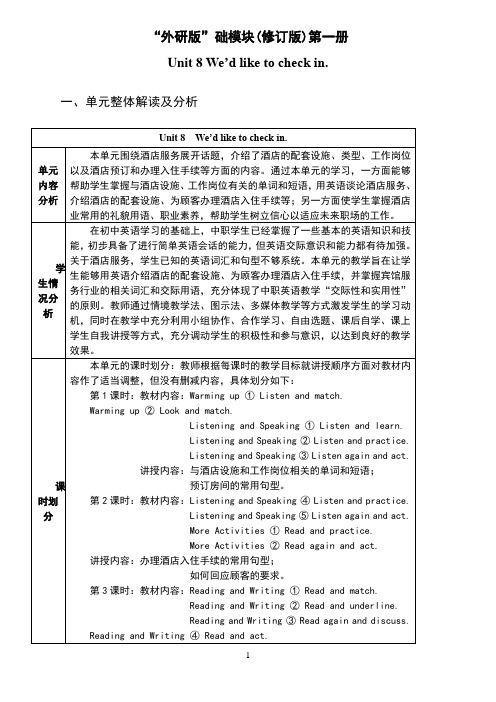
double room vs. twin room
第 2 课时
语言知识:1. 掌握用于办理酒店入住手续的句型,如:
I’d like to check in, please.
Just a moment.
You’ve booked a suite.
Here’s your key card.
教 Enjoy your stay.
2)第二遍听录音 放录音并跟读,老师简要讲
解对话中的重要句型,如: a. This is... Hotel. b. May I help you c. What kind of room would
you like d. A single room/ double
学生跟读、朗 读对话,熟悉对话 内容,记忆关键词 和重点句子,尝试 复述。
掌握常用于预订房间的重点词汇和基本用语。
运用相关句型准确地表述预订房间的对话。
情境教学法。
2
法
学
习 方
合作学习法。
法
教
学 媒
酒店预订的视频资料、教学 PPT、酒店登记卡片。
体
教学过程
预教
设学 时环
教师活动
学生活动
设计意 图
间节
上课前,教师将全班同学分成 6
按老师要求摆
创设虚
组,每 8 名学生为一组。要求每组 放好桌椅,写好卡 拟职业场景,
Listening and Speaking ① Listen and learn.
Listening and Speaking ② Listen and practice.
Listening and Speaking ③ Listen again and act.
unit8We27dliketocheckin课件

Reading and Writing
4 Read and act. 读下列对话,猜一猜对话发生的地点,
并表演对话。
— May I help you? — Yes. I want to have a swim. —OK. This way, please.
—我可以帮您吗? —是的,我想游泳。 —好,这边请。
Reading and Writing
4 Read and act. 读下列对话,猜一猜对话发生的地点,
并表演对话。
— What can I do for you, sir? — I need my shirt washed. —OK. Fill in the laundry list, please.
参考译文
礼貌用语很重要,注意学习使用下列礼貌用语:
May I help you? Enjoy your stay.
该句是现在完成时态,用于表述发生在过去,到 现在为止已经完成或仍在持续的动作或状态。
例如:We have finished the homework.
服务员:您好,我可以帮助您吗? 史密斯先生:是的,我想办理入住手续。我叫约翰•史密
Warming up
twin room
(有两张单人床的)双人房间
Listening and Speaking
1 Listen and learn. 听录音,了解酒店的一些工作岗位。
bellboy n. 行李员 desk clerk 前台服务员
cleaner n. 清洁工人 waiter n. 男服务员
S1: Hello, Grand Hotel. May I help you? S2: Hello, I’d like to book a room. S1: What kind of room would you like? S2: A single room, please. S1: May I have your name, sir? S2: Jack Brown.
We’d like to check in单元教案
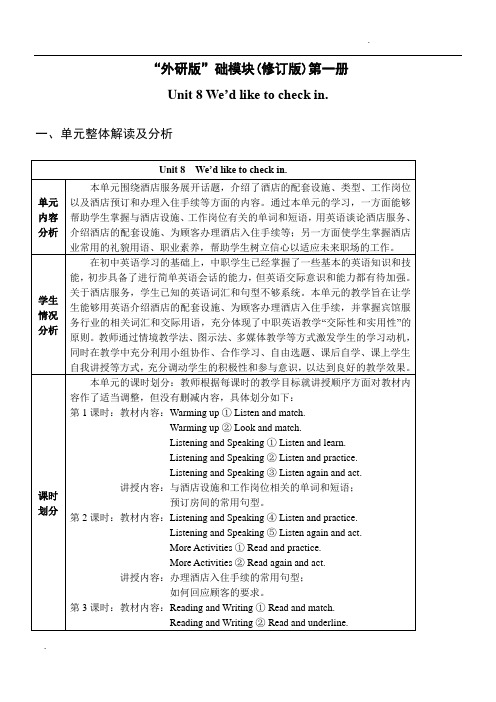
以小组为单位制作一张“登记卡”,并根据登记卡上的内容编写一组以预订房间为主题的对话。
帮助学生复习本节课的学习重点,为下节课办理入住手续的学习做好铺垫。
板书设计
PPT
Unit 8We’d like to check in.
This is ... Hotel. May I help you?
What kind of room would you like?
了解世界各地的特色酒店;
使学生了解自己对本单元的掌握情况。
二、分课时教学设计
第1课时
教学
目标
语言知识:1.掌握与酒店设施和工作岗位相关的单词和短语如:single, double, bar, suite, guest room, front desk, bellboy, desk clerk, twin room, double room, book a room等;
按老师要求摆放好桌椅,写好卡片并坐好。
创设虚拟职业场景,激发学生的学习兴趣,为合作学习做好铺垫。
2’
导入
1.教师向学生展示本单元首页的图片并提问:Let's look at this picture and discuss:
1)Where are they?
2)What are they doing?
第4课时:教材内容:Reading and Writing⑤Read and learn.
Reading and Writing⑥Read again and fill.
Around the World
Fun time
My Progress Check
讲授内容:使用酒店英语介绍相关教学内容,为客人挑选适合的酒店;
Unit8 we‘d like to check in 教案 公开课教学文稿
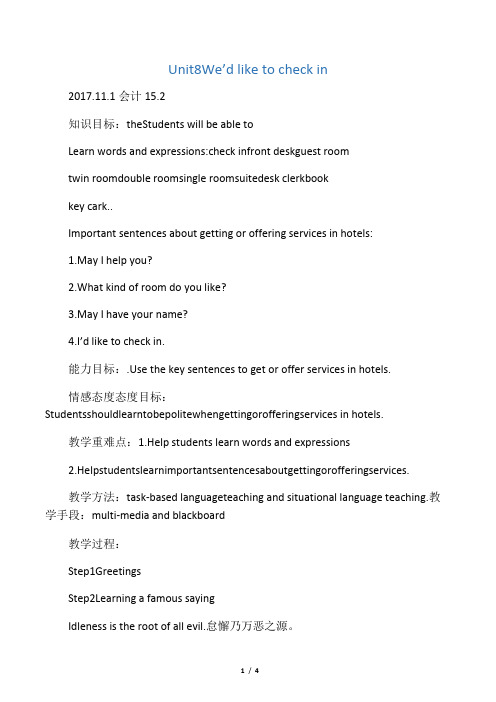
Unit8We’d like to check in2017.11.1会计15.2知识目标:theStudents will be able toLearn words and expressions:check infront deskguest roomtwin roomdouble roomsingle roomsuitedesk clerkbookkey cark..Important sentences about getting or offering services in hotels:1.May I help you?2.What kind of room do you like?3.May I have your name?4.I’d like to check in.能力目标:.Use the key sentences to get or offer services in hotels.情感态度态度目标:Studentsshouldlearntobepolitewhengettingorofferingservices in hotels.教学重难点:1.Help students learn words and expressions2.Helpstudentslearnimportantsentencesaboutgettingorofferingservices.教学方法:task-based languageteaching and situational language teaching.教学手段:multi-media and blackboard教学过程:Step1GreetingsStep2Learning a famous sayingIdleness is the root of all evil.怠懈乃万恶之源。
Step3RevisionReview the words and expressions learned yesterday.Step4Lead-in1.Show a picture to the students on the screen and make a discussion:a.Where are they?b.What are they doing?Step 5 warming up2.Show the pictures about hotelsHotel lobbyfront deskmeeting roomguybarguest room3.Asking and answeringa.Have you ever lived in a hotel?b.Do you know how to check in?Step5Listening and speaking1.Listen to the dialogue1)Ask students to listen carefully, then choose the right answer.Mr. Smith would like to book_____CA.a twin roomB. a single roomC. a suite2..Listen again and the check the answers.3.Ask the students to read the dialogue aloud ,then underline the importantsentences.4.Listen to the dialogue 2 about check-in.Ask students to listen to tape, then choose the answers.1)What dose Mr. Smith want to do____?() check out()check in()pay the bill2)3)What does the clerk need to do ?()check the name()show the bill()give him the key card5.Read the dialogue aloud and then underline the important sentences.6.Practice the dialogue and then act it out.Step 6 task 1Think and discuss what a clerk or a guest might say.1)Good evening! May I have you?-------clerk2)What kind of room would you like?-----clerk3)4)May I have you name?-----clerk5)Yes,I’d like to book a room./I’d like to check in.------guest6)Do you have a reservation?-------clerk7)Just a moment, please!I’ll che ck it for you.--------clerk8)Here is your key card.-----clerk9)10)Enjoy your stay.-----clerkTask 2Match daily English交际用语连线(1)May I help you?A. JohnSmith(2)(3)What kind of room do you like?B. Yes,I’d like to check in.(4)Just a moment ,oh, yes, you’veC. A suitebooked a single room for four nights.D .Exactly(5)(6)(7)(8)May I have your name please?E. Thanks Your room is 803 and hereisthe key card, enjoy your stay.Step 7 Summary and homeworkSummaryWe’ve learned some words and expressions about bo oking a roomor checking in at a hotel and learned to get or offer services in hotel.Homework2.3.4.5.7.learn the new words and expressions by heart.9.10.11.Read the two dialogues aloud ,try to recite them.。
- 1、下载文档前请自行甄别文档内容的完整性,平台不提供额外的编辑、内容补充、找答案等附加服务。
- 2、"仅部分预览"的文档,不可在线预览部分如存在完整性等问题,可反馈申请退款(可完整预览的文档不适用该条件!)。
- 3、如文档侵犯您的权益,请联系客服反馈,我们会尽快为您处理(人工客服工作时间:9:00-18:30)。
15’
输出
2. 观看酒店预订的视频短片,展现 预订房间的真实情景。
学习真实情境中的 服务礼仪规范。
示范职场礼 仪,展示规 范、礼貌的服 务态度。
2’
板书 设计
3. 让 学 生 两 人 一 组 , 根 据 活 动 根据图片内容和提 激 发 学 生 的
Listening and Speaking ③中的图 示 创 作 对 话 并 表 参 与 意 识 和
在初中英语学习的基础上,中职学生已经掌握了一些基本的英语知识和技 能,初步具备了进行简单英语会话的能力,但英语交际意识和能力都有待加强。 关于酒店服务,学生已知的英语词汇和句型不够系统。本单元的教学旨在让学 生能够用英语介绍酒店的配套设施、为顾客办理酒店入住手续,并掌握宾馆服 务行业的相关词汇和交际用语,充分体现了中职英语教学“交际性和实用性” 的原则。教师通过情境教学法、图示法、多媒体教学等方式激发学生的学习动 机,同时在教学中充分利用小组协作、合作学习、自由选题、课后自学、课上 学生自我讲授等方式,充分调动学生的积极性和参与意识,以达到良好的教学 效果。
第 2 课时
教学 目标
教学 重点 教学 难点 教学 方法 学习 方法 教学 媒体
语言知识:1. 掌握用于办理酒店入住手续的句型,如: I’d like to check in, please. Just a moment. You’ve booked a suite. Here’s your key card. Enjoy your stay.
本单元的课时划分:教师根据每课时的教学目标就讲授顺序方面对教材内 容作了适当调整,但没有删减内容,具体划分如下: 第 1 课时:教材内容:Warming up ① Listen and match.
Warming up ② Look and match. Listening and Speaking ① Listen and learn. Listening and Speaking ② Listen and practice. Listening and Speaking ③ Listen again and act. 讲授内容:与酒店设施和工作岗位相关的单词和短语; 预订房间的常用句型。 第 2 课时:教材内容:Listening and Speaking ④ Listen and practice. Listening and Speaking ⑤ Listen again and act. More Activities ① Read and practice. More Activities ② Read again and act. 讲授内容:办理酒店入住手续的常用句型; 如何回应顾客的要求。 第 3 课时:教材内容:Reading and Writing ① Read and match.
让学生和搭档练习,抽查。
1. Pre-listening:
学生做动作,模仿 引 导 学 生 了
学习关于工作岗位的词汇:
各个岗位的工作内 解 相 关 工 作
1)教师提问:
容,并回答问题。 岗位的职责,
What does a bellboy / desk 例 : A bellboy 激 发 学 生 的
clerk / cleaner / waiter do? opens the door 学习兴趣。
学生说出 Warming up②中的图片匹配 答案。 学生替换练习描述 酒店设施的简单句
词汇归类,并 在句型的练 习使用中强 化对词汇的 记忆,为下面 的学习做好 铺垫。
精品
导示范学生回答:
.
子。
精品
.
The gym is just over there. The
gym is free of charge.
1. 让学生先看 Warming up①中的词 语,然后听录音,再将所听到的句 子中的关键词语与图片配对。
2. 让学生再听一遍录音,检查自己
学生听录音,并将 所听到句子中的关 键词语与图片相匹 配。
学生说出更多关于
运用视听结 合的形式讲 解新词,激发 学生的学习 动机,提高单 词记忆效率,
6’
的匹配结果是否正确。拓展:让学 酒店设施的英语名 引 导 学 生 对
兴趣,为合作
学生两两相对而坐,每组成员自主 分配好角色,书桌一侧学生为 clerk,另一侧的学生的为 guest。
学习做好铺 垫。
1. 教师向学生展示本单元首页的
运用图片展
图片并提问:Let's look at this
示及提问的
picture and discuss:
方式,引导学
1) Where are they?
They’re in a 生 明 确 本 单
2’ 导入 2) What are they doing?
hotel.
元的学习主
The desk clerk is 题 和 学 习 目
giving a card to 标。 2. 通过学生的回答导出本单元的 the boy. 话题,We’d Like to check in。
训练学生根 据所听内容 筛选关键信 息的能力。
2)第二遍听录音 放录音并跟读,老师简要讲解对 话中的重要句型,如: a. This is... Hotel. b. May I help you? c. What kind of room would you like? d. A single room/ double room / twin room / suite, please. e. May I have your name please? 教师在黑板上写出对话中的关 键词,然后两人一组朗读对话, 教师进行抽查检测。
二、分课时教学设计
第 1 课时
教学 目标
教学 重点 教学 难点 教学 方法 学习
语言知识:1. 掌握与酒店设施和工作岗位相关的单词和短语如:single, double, bar, suite, guest room, front desk, bellboy, desk clerk, twin room, double room, book a room 等;
媒体
教学过程
预设 教学 时间 环节
教师活动
学生活动
设计意图
上课前,教师将全班同学分成 6 组, 按老师要求摆放好 创 设 虚 拟 职 每 8 名学生为一组。要求每组学生 桌椅,写好卡片并 业场景,激发
课前 将书桌并排放置,在桌上摆放自制 坐好。
学生的学习
准备 的写有"Front desk"字样的卡片。
2. 理解并掌握描述酒店设施的简单句子和常用于预订房间的基本 交际用语: The front desk is just over there. The gym is free of charge. This is...Hotel. May I help you? What kind of room would you like? A single / double / twin room / suite, please. May I have your name, please?
跟读与酒店工作岗位有关的词 称相关的词汇。 发音。
汇。
15’
讲授
2. While-listening: 1)第一遍听录音
让 学 生 听 活 动 Listening and Speaking ②中的录音,根据听 到的对话填写登记卡。请学生就 登记卡中的主要信息进行回答。
学生根据听到的对 话填写登记卡,回 答上面的问题。
A single / double / twin room / suite,
please.
May I have your name please?
Could you spell your name,please?
精品
.
Could you fill in the form, please? double room vs. twin room
学习重点,为
下节课办理
作业 2. 作业:
入住手续的
以小组为单位制作一张“登记
学习做好铺
卡”,并根据登记卡上的内容ห้องสมุดไป่ตู้写
垫。
一组以预订房间为主题的对话。
PPT
Unit 8 We’d like to check in.
This is ... Hotel. May I help you?
What kind of room would you like?
通过跟读、替 学生跟读、朗读对 换练习、创设 话,熟悉对话内容, 情 境 表 演 对 记忆关键词和重点 话等形式,巩 句子,尝试复述。 固 预 订 房 间
相关的基本 交际用语,锻 炼学生的英 语交流能力。
精品
.
3)第三遍听录音
替换练习、表演对
教师引导学生归纳更多与预订 话,小组成员相互
房间有关的基本用语,并写在黑 检查,推荐最佳搭
板上,让学生两人一组复述、替 档。
换练习、模拟真实情景表演对
话,组内检查并推荐一组在班内
表演。
1. 老 师 简要 讲 解 Tips 中 double 了 解 Tips 中 区别词义,避
room 和 twin room 的区别。
double room 和 免 工 作 中 的
twin room 的区别。 错误。
让学生做动作,模仿各个岗位 and helps guests
的工作内容,其他学生用英语 carry luggage. /
说出词汇和岗位的名称。
A cleaner cleans
the rooms....
2 ) 让 学生 听 活动 Listening and
通过朗读学
Speaking ①中的录音,并大声 朗读学习与岗位名 习词汇,准确
